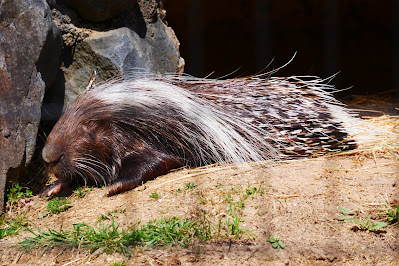Among their major differences are the fact that Sitatunga coats are thick and slightly shaggy, white Lesser Kudu bear short hair that tends to reflect sunlight with a little shimmer. This makes sense when you know that Sitatunga live in swampy forested areas with lots of shade, while Lesser Kudu live on the open savanna's. One of my favorite differences is in the way in which the two species react to danger. Not surprisingly the Lesser Kudu are excellent runners and flee. The Sitatunga, however, are excellent swimmers and they will seek safety by hiding in water! They will submerse their entire bodies with the exception of their nostrils and wait patiently for the danger to pass.
The Maryland Zoo has very successful breeding programs for both species. Presently, our most recent Sitatunga buck passed into Ancestry last autumn, and so our herd consists of nine females, eight adults and one yearling. We are awaiting a replacement male as the Association of Zoos and Aquariums decides on the best fit for our herd to ensure the greatest genetic diversity within the stock of Sitatunga within their care. Our herd of Lesser Kudu is a but smaller. We have two long-time female residents: Lemon and Meringue. Meringue is Lemon's offspring. We have a young new Buck, Zahi, who will be turning 3 this year. He's been with us just over a year and wasted no time getting together with Meringue, who last summer bore Mandazi, a lovely male. As Mandazi matures, he will necessarily be transferred to another zoo where he can carry on his lineage. Lemon is probably past calf bearing years at this point in her life.Sitatunga females are this bright burnt umber color, while the males are a dusky hickory brown.
Zahi with his crown of spiral horns basking in the warm sun.
Old Kayin (pronounced Cane) also sleeping the warm sun.
Finally, on the bright, slightly cool breezy day of my visit the warthogs were out. The Maryland Zoo is home to two, a companion pair. Hodor is our male and he was born at the Detroit Zoo in 2015. KeeWee is our female and a member of the last litter of warthogs born at the Maryland Zoo, also in 2015. Warthogs are one of the species for whom life expectancy varies greatly between wild and captive populations. In the wild a range of 7 to 11 is generally accepted; however, in the care of a zoo or wildlife refuge that can commonly live to 20 or beyond. On this day, I caught KeeWee peering at me through the camouflage of an upended tree stump--which is incongruous when you consider just how poor warthog's eye sight is! It is more likely that the sound of my voice caught her attention and then she's waiting to catch a whiff of human odor to confirm what her ears were telling her.









No comments:
Post a Comment